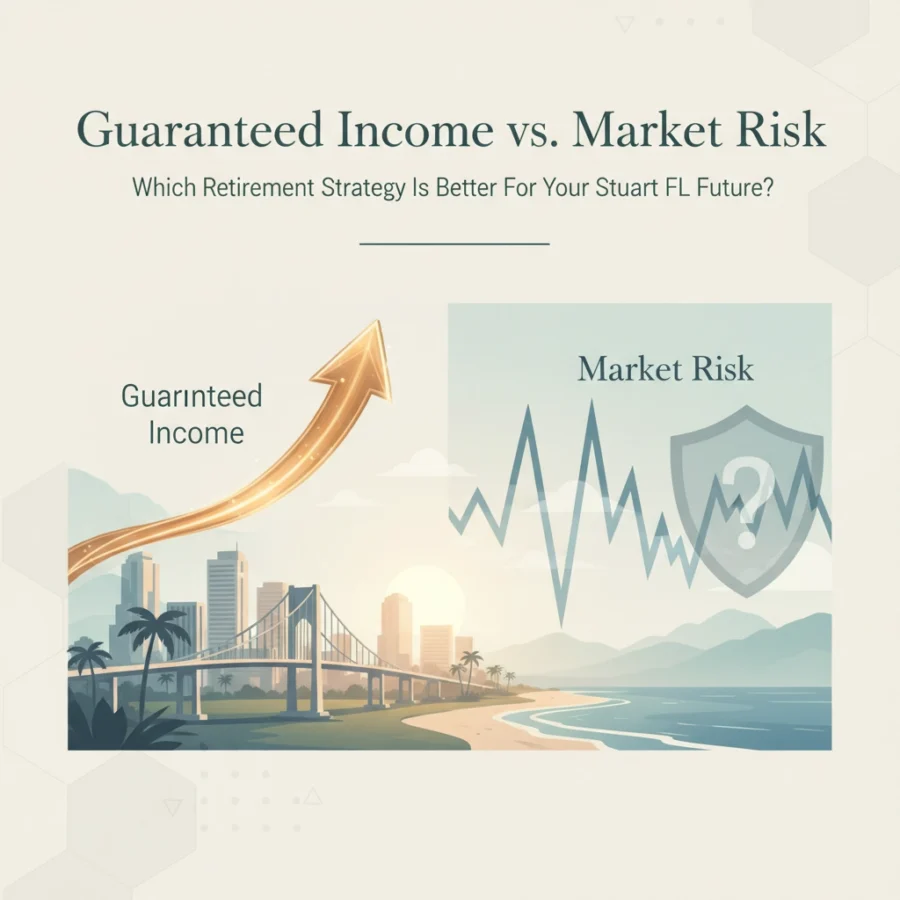When you’re planning for retirement in Stuart, Florida, you face a fundamental choice that keeps many pre-retirees awake at night: Should you prioritize guaranteed income that never varies, or embrace market-based strategies that offer growth potential alongside uncertainty?
This decision has become increasingly complex as life expectancies rise and traditional pensions disappear. The average 65-year-old today has a 50% chance of living to age 85, and a 25% chance of reaching 90. With potentially three decades of retirement ahead, your income strategy needs to work not just for the first few years, but for the long haul.
Let’s examine both approaches so you can make an informed decision for your unique situation.
The Guaranteed Income Approach: Security First
Guaranteed income strategies center on converting a portion of your retirement savings into predictable, lifetime payments. This typically involves annuities: insurance products that provide fixed monthly payments regardless of market conditions.
The appeal is straightforward: you know exactly what you’ll receive each month for the rest of your life. If you purchase an immediate fixed annuity with $300,000 at age 65, you might receive approximately $1,800 monthly for life, regardless of whether the stock market crashes or soars.
Key Advantages:
Your essential expenses: housing, utilities, healthcare, food: are covered no matter what happens in the markets. This eliminates sequence of returns risk, the danger of poor market performance early in retirement forcing you to sell investments at depressed prices. You can budget with complete certainty and sleep soundly knowing your income is secure.
The Trade-offs:
Guaranteed income comes with limitations. Once you convert assets to an immediate annuity, you typically lose access to the principal. If you need $50,000 for a medical emergency, that money isn’t available. Additionally, fixed payments lose purchasing power over time. Your $1,800 monthly payment has significantly less buying power in year 20 of retirement than in year one.

Market-Based Strategies: Growth Potential with Volatility
The probability-based approach relies on portfolio withdrawals from diversified investments. The classic “4% rule” suggests withdrawing 4% of your portfolio value in year one, then adjusting for inflation annually. With a $750,000 portfolio, you’d start with $30,000 in annual withdrawals.
Historical data shows this approach has worked well over most 30-year periods, with stock market returns averaging approximately 10% annually over the long term. Your portfolio has the potential to grow faster than inflation, potentially leaving substantial assets for your heirs.
The Growth Advantage:
Market-based strategies offer flexibility and upside potential. If your investments perform well, you can increase spending. You maintain full control over your assets and can access principal when needed. During strong market years, your standard of living can improve rather than remain static.
The Risk Reality:
This approach carries significant sequence of returns risk. Consider a retiree who began withdrawing in early 2000, just before the dot-com crash and subsequent bear market. Poor returns in the first decade of retirement can permanently impair your portfolio’s ability to recover, even if markets eventually rebound.
Recent research shows that a 30% portfolio decline in your first year of retirement transforms a sustainable 4% withdrawal rate into an unsustainable 5.7% rate, dramatically increasing the probability of depleting your savings.
Comparing the Strategies: A Clear Framework
| Factor | Guaranteed Income | Market-Based |
|---|---|---|
| Monthly Income Predictability | Fixed for life | Variable with markets |
| Inflation Protection | Poor (unless indexed) | Potential through growth |
| Liquidity Access | Limited to none | Full access |
| Longevity Risk | Eliminated | Significant concern |
| Legacy Potential | Minimal | Full remaining balance |
| Market Stress Impact | None | Direct portfolio impact |
| Upfront Costs | Higher (insurance fees) | Lower (investment fees only) |
The Florida Factor: Why Location Matters
Living in Stuart brings unique considerations to this decision. Florida’s lack of state income tax means your retirement dollars stretch further, but rising property insurance costs and healthcare expenses can impact your budget unpredictably.
Many Florida retirees find that guaranteed income provides peace of mind during hurricane seasons when property values and insurance costs fluctuate. However, the state’s relatively high cost of living in desirable coastal areas like Martin County means inflation protection becomes crucial for maintaining your lifestyle over a 20-30 year retirement.

The Hybrid Solution: Best of Both Worlds
Rather than choosing one approach exclusively, most financial professionals recommend a combination strategy. This involves using guaranteed income to cover your essential expenses while maintaining market-based investments for discretionary spending and growth.
Here’s how it works: Calculate your non-negotiable monthly expenses: mortgage or rent, utilities, insurance, food, basic healthcare. Then allocate enough assets to guaranteed income products to cover these essentials. Deploy your remaining portfolio assets in a growth-oriented strategy for travel, dining, hobbies, and other discretionary goals.
A Practical Example:
Sarah, a 64-year-old Stuart resident, has $800,000 in retirement savings. Her essential monthly expenses total $3,500. She allocates $350,000 to a combination of immediate annuities and delayed annuities to generate $3,500 monthly starting at age 65. Her remaining $450,000 stays invested in a diversified portfolio for growth and flexibility.
This approach provides multiple benefits: her essential needs are secure regardless of market performance, she maintains flexibility for discretionary spending, and she retains upside potential for inflation protection and legacy planning.
Advanced Strategies: Modern Guaranteed Income Options
Today’s guaranteed income landscape offers more sophisticated options than traditional immediate annuities. Fixed indexed annuities provide guaranteed minimums with upside potential tied to market indices. Guaranteed Lifetime Withdrawal Benefits (GLWBs) within variable annuities offer portfolio growth potential with income floor protection.
Recent legislative changes through the SECURE Act have made these options more accessible within employer retirement plans, often with institutional pricing that reduces costs compared to retail products.
Making Your Decision: Key Questions to Consider
Your optimal strategy depends on several personal factors:
Risk Tolerance: How would you sleep if your portfolio dropped 30% in your first year of retirement? If this scenario keeps you awake, guaranteed income should play a larger role in your strategy.
Family Longevity: If your parents and grandparents lived well into their 90s, longevity risk becomes more significant, favoring guaranteed income approaches.
Legacy Goals: Do you want to maximize inheritance for your children, or is your primary concern ensuring you don’t become a financial burden? Your answer influences the guaranteed versus market-based allocation.
Flexibility Needs: How important is access to your principal for emergencies, opportunities, or changing circumstances?

Professional Guidance: Navigating Complex Decisions
These decisions involve intricate trade-offs between competing priorities. The optimal approach for your situation requires analyzing your complete financial picture, including Social Security benefits, pension income, healthcare costs, estate planning goals, and tax considerations.
At Davies Wealth Management, we work with Stuart-area retirees to model different scenarios and stress-test retirement income strategies. We can show you how various guaranteed income and market-based combinations would perform under different economic conditions, helping you make informed decisions aligned with your priorities and risk tolerance.
Our comprehensive approach includes analyzing how your retirement income strategy integrates with your overall estate plan. Many clients discover that the right combination of guaranteed and market-based income not only provides security but also optimizes tax efficiency and legacy planning opportunities.
Your Next Steps
The choice between guaranteed income and market-based retirement strategies isn’t binary: it’s about finding the right balance for your unique situation. Whether you prioritize security, growth, flexibility, or legacy planning, the optimal solution likely involves elements of both approaches.
Ready to develop a comprehensive retirement and estate planning strategy tailored to your Stuart lifestyle? Our team can help you model different scenarios, compare options, and create an integrated plan that addresses both your retirement income needs and estate planning goals.
Take the first step toward securing your retirement future by exploring our comprehensive estate planning resources and scheduling a consultation to discuss your specific situation.



Leave a Reply